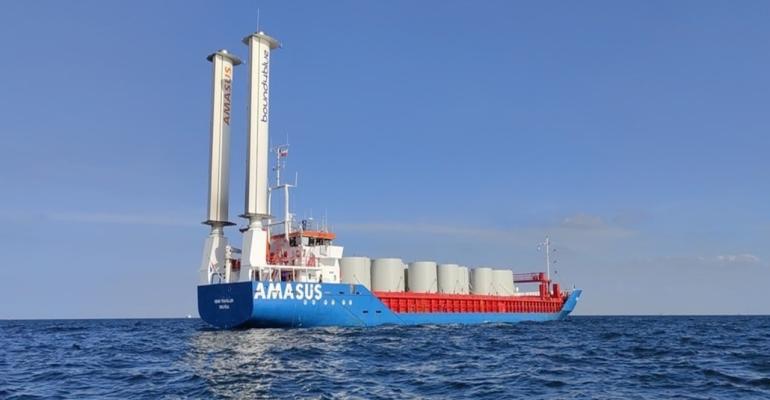Increasing numbers of orders for wind assisted propulsion demonstrate a growing confidence in the technologies at a time regulation is increasing the commercial benefits of systems, bound4blue COO & Co-founder Cristina Aleixendri told Seatrade Maritime News.
“Owners used to send their oldest ships for preliminary analysis for sails, maybe due to CII, maybe due to perceived risk. Now they want them on their new ships, even good, CII-compliant ones.”
Earlier this year, bound4blue received its first newbuild order for its eSAILs technology for a multipurpose cargo vessel due for delivery in 2026.
“We see a change of mindset from shipowners, the perception of risk is lowered, and they want to invest in technology for the long run, for the lifetime of a ship,” said Aleixendri.
A major factor which has changed in bound4blue’s nine-year history is the commercial value of reducing carbon emissions under regulations like EU ETS and the upcoming FuelEU Maritime. While fuel savings have always been a commercial driver, regulations have changed the equations that dictate which vessels and routes will financially benefit from wind assisted propulsion.
“If you asked me a few years ago before FuelEU and EU ETS, I would have said the North Atlantic, North Pacific and Baltics were routes with a good business case for wind propulsion. Now, some owners will have a better business case by sailing in Europe with wind,” said Aleixendri.

Louis Dreyfus Company (LDC) will install eSAILs on its juice vessel Atlantic Orchard, chartered from Wisby Tankers, and has benefitted from cutting its greenhouse gas (GHG) emissions.
“The LDC ship sails about half of the time in EU waters. Around half of its savings come from not paying compliance costs with FuelEU and EU ETS, building the business case,” said Aleixendri. The regulatory support makes wind propulsion viable on routes where winds may otherwise have been marginal from a commercial standpoint, she added.
When FuelEU Maritime comes into force in January 2025, wind propulsion will be the only technology with a reward factor under the regulation, crediting vessels using such technologies by reducing the GHG intensity of energy used onboard. “We’re seeing that charterers are very aware of FuelEU and open to discussing the FuelEU effect,” said Aleixendri.
Alongside regulation, hard data and experience from operating wind-assisted vessels have reduced the perceived risks associated with investing in new technologies, Aleixendri believes. With such wide changes in weather and operating conditions at sea, long-term analysis gives the most honest account of the impact of wind power systems on a ship.
“We really believe in long term, validated data, delivered and really explained. It’s not enough to give a number, we need to explain what’s behind that number, any assumptions that have been made and why, any cleaning that has been done to the data.”
Data from Amasus Shipping’s Eems Traveller is currently being validated by Lloyd’s Register and will be used to demonstrate how operating eSAILs affects vessel performance.
bound4blue currently has three projects in the tanker segment with Eastern Pacific Shipping, Odfjell, and Marflet Marine; one general cargo with Amasus; one converted bulker operating as a juice carrier for LDC; a ro-ro vessel with Louis Dreyfus Armateurs; and the newbuild multipurpose cargo vessel for French Polynesia.
Copyright © 2024. All rights reserved. Seatrade, a trading name of Informa Markets (UK) Limited.
Add Seatrade Maritime News to your Google News feed.  |

